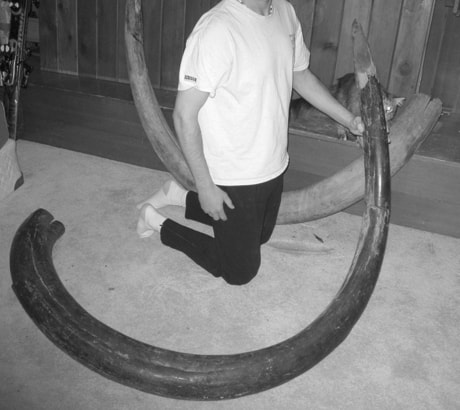WHITEHORSE — Whitehorse sculptor James Kirby once used mammoth ivory as a medium for his artwork, but now restores the ancient material instead of carving it.
Ivory dust clouds the air in Kirby’s downtown studio as he goes about beautifying a two-metre tusk he estimates is between 35,000 and 40,000 years old.
Mammoths are essentially grazers like a cow with large flat teeth for grinding grass, compared with mastodons whose teeth have large cusps for grabbing branches of trees and shrubs.
The fossil Kirby’s working on was unearthed several years ago near a Dawson City Yukon gold claim.
Kirby was asked to refurbish it for a local collector, he said, as he described the process of putting the tusk back together.
“First I take tiny dental tools to pick out all the granulated sand and rot and check the areas that need to be filled. But before this, you have to let it sit for at least a year in a cool dry place.”
Many tusks emerge from former or current permafrost conditions or from inside eroding river banks, causing moisture and temperature variations, particularly after they’re removed from the ground.
That causes many tusks to split down and through the centre.
The specimen Kirby is currently restoring required filling some portions with epoxy, clamping the tusk at various points along its length and waiting.
“It takes about a month to do this in total,” Kirby said. “And this tusk won’t be museum quality because (by using epoxy) I’m not preserving its original state. So you’d consider this a vanity piece.”
For years, Kirby created his evocative sculptures from mammoth ivory but stopped “because Asia flooded the market with cheap carvings made from Yukon ivory.”
“But at least this tusk will be preserved and will stay in the Yukon,” he said. “That’s what I get off on and that’s why I do it.”
Three rules govern fossils found in the Yukon.
The Historic Resources Act covers those that are found on private or territorial Crown land while federal parks legislation deals with fossils discovered in a national park. If they’re unearthed on First Nations settlement land, the resource belongs to that land claim group.
While the Historic Resources Act considers all uncovered fossils property of the territory, Jeff Hunston, the territory’s manager of heritage resources, said decisions on what items the government expropriates are dependent on a specimen’s scientific worth.
“If it’s incomplete, it has virtually no (research) utility,” Hunston said. “And there’s an industry in the Yukon that uses ivory for jewelry and we encourage that and want that to continue and provide jobs.”
Fossils like the one Kirby is restoring are considered incomplete because the tusk is not attached to part of or an entire skull.
Hunston’s department relies on the co-operation of First Nations and the placer industry to report finds.
“When miners find this stuff, we have a paleontologist on staff that goes out to the gold fields and visits the mines and works to recover significant specimens and we’ve built up a significant collection of ice-age mammoth bones,” he said.
He said the 1993 discovery by placer miners of an intact ice age Yukon horse at Last Chance Creek was significant.
“A preserved scimitar cat or flat-faced giant bear, now that would really be mind-blowing if we found that.”
Hunston said ongoing co-operation between the government and Vuntut Gwitchin First Nation is leading to further excavation of the Old Crow Flats, which he calls a treasure trove of ancient animal bones.
Government paleontologist Grant Zazula, whose job includes rating the significance of fossils dug up in the territory, said mammoths roamed the Yukon and Alaska until about 7,000 years ago.
“In the context of evolution and geology, 7,000 years ago is like yesterday,” he said.
Mammoth tusks are much larger than a mastodon’s, distinguished by their long pronounced curves.
“Mastodon tusks are short little straight things,” Zazula said. “One of the mistakes people say is ‘It’s a mastodon tusk.’ Almost 90 per cent of the large elephant bones found in the Yukon are mammoth.”
